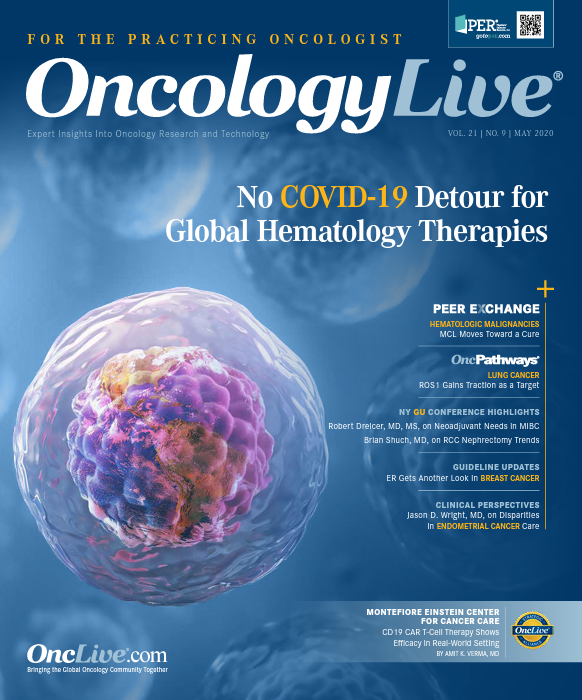Expert Explains Significance of Tazemetostat FDA Approval for Rare Sarcoma
Brian Van Tine, MD, PhD, discusses what tazemetostat’s approval brings to the treatment landscape for patients with epithelioid sarcoma.
Brian Van Tine, MD, PhD, an associate professor in the Department of Medicine, director, Sarcoma Program, Division of Medical Oncology, Washington University School of Medicine in St. Louis

Brian Van Tine, MD, PhD
The armamentarium for patients with epithelioid sarcoma, a rare soft tissue sarcoma that primarily affects younger adults, now includes the novel targeted therapy tazemetostat (Tazverik). On January 23, 2020, the FDA granted an accelerated approval to the first-in-class EZH2 inhibitor, for the treatment of adult and pediatric patients 16 years and older with metastatic or locally advanced epithelioid sarcoma not eligible for complete resection.
The approval is based on findings from a cohort of patients with epithelioid sarcoma (cohort 5) in an ongoing, phase 2 study (EZH-202; NCT02601950). Investigators enrolled 62 patients with locally advanced or metastatic epithelioid sarcoma whose tumors lacked integrase interactor 1 (INI1) expression. Treatment with tazemetostat elicited an overall response rate of 15% (95% CI, 7%-26%), including a 1.6% complete response rate and a 13% partial response rate. Among the responders, 67% had a duration of response of at least 6 months (range, 3.7-24.5+).1
“[Tazemetostat] is an advance over [other] treatments for epithelioid sarcoma because now we have a targeted therapy that has a mechanism and a biomarker,” Brian Van Tine, MD, PhD, said in an interview with OncLive®. “We don’t usually talk about response rates in sarcoma, especially past first line. In general, this is a chemo-insensitive subset of sarcoma. The fact that there is a response rate is exciting.”
Epithelioid sarcoma is characterized by an aggressive behavior and a very poor prognosis, with metastases occurring in 30% to 50% of cases. Available treatment options have consisted primarily of anthracycline-based and gemcitabine-based chemotherapy, which have median progression-free survival rates of between 3 and 8 months.2
Van Tine, an associate professor of medicine in the Division of Oncology, Section of Medical Oncology, at Washington University School of Medicine in St Louis and an investigator in the trial, discussed what the agent’s approval brings to the treatment landscape for this patient population.
OncLive: Please provide an overview of the study that led to the approval of tazemetostat.
Van Tine: This was a multicenter, multicohort, phase 2, 7-arm study looking at different types of tumors. For example, there was a synovial sarcoma arm, an epithelioid sarcoma arm, [and] a rhabdoid tumor arm. Each of these had a biology that was predicted to respond to an EZH2 inhibitor. Two of the cohorts were for epithelioid sarcoma, with one of those requiring biopsies. There was an enrichment cohort once it was shown there was a signal to better understand the biology.
The biomarker that was used was loss of INI1 expression, which is part of the pathological workup for epithelioid sarcoma. This multiarm study, which provided a way of looking at many kinds of tumors, identified activity only in epithelioid sarcoma.
What is the mechanism of action of tazemetostat?
It is a small molecule EZH2 inhibitor. It is thought that the loss of INI1 would lead to increased EZH2 activity. There is large complex of chromatin remodeling proteins called SMARC. In the SMARC family, proteins come together to regulate chromatin modifications. One of those proteins is INI1. When you lose INI, you lose control of a protein called EZH2, which gets upregulated and starts modifying DNA. If you inhibit EZH2, the activity that is useful for cancer, you can get control of the chromatin modification in a way that tumors don’t like. You are driving a mechanism based on a loss of a protein that leads to upregulation of the protein.
Please discuss efficacy data.
The data cutoff was September 17, 2018. Patients with epithelioid sarcoma were treated with 800 mg of tazemetostat twice a day. They could have any line of prior treatment. There was a 15% partial response [rate] and a disease rate of 26%, but what was interesting is that the disease control rate was up to 103 weeks. The median overall survival in a chemo-insensitive type of sarcoma was 82 weeks. In general, compared with a lot of agents we use, this was relatively well tolerated. In terms of adverse [events], the biggest complaint was fatigue, nausea, and cancer pain.
Please discuss the other studies that are ongoing with tazemetostat.
We are currently participating in the phase 2 expansion, which is for patients who have already been treated. We are also participating in a phase 3 study [EZH-301; NCT04204941] that combines tazemetostat with doxorubicin. The expansion study is open label and open-ended. It gives patients access, but also, biologic data are being collected. The phase 3 trial is required by the FDA for continued approval. This is expected to be completed by 2029, and that is reflective of how rare this sarcoma is.
What are the recommendations for clinicians when using tazemetostat?
This is only for epithelioid sarcoma, and pathology should be confirmed. It’s important to match the drug to the right patient. Epithelioid sarcoma is a distinct sarcoma, and now there is a drug for it: Tazemetostat.
References
- Tazverik. Package insert. Epizyme, Inc; 2020. Accessed April 13, 2020. www.accessdata.fda.gov/ drugsatfda_docs/label/2020/211723s000lbl.pdf
- Stacchiotti S, Schoffski P, Jones R, et al. Safety and efficacy of tazemetostat, a first-in-class EZH2 inhibitor, in patients (pts) with epithelioid sarcoma (ES) (NCT02601950). J Clin Oncol. 2019;37 (suppl 15):11003. doi:10.1200/JCO.2019.37.15_suppl.11003




